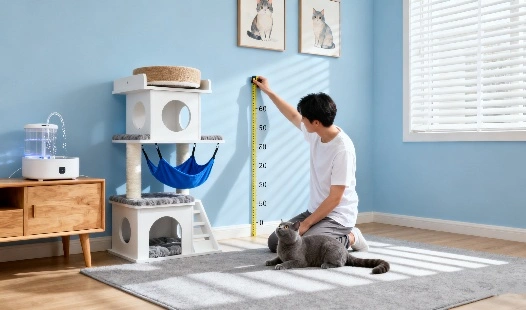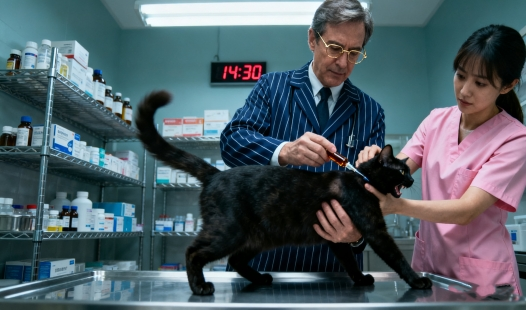Epidemiological Factors of FCoV Transmission in Multi-Cat Environments
Feline coronavirus (FCoV), the precursor virus to FIP, spreads primarily through the fecal-oral route. In multi-cat households, several key factors influence transmission dynamics:

Population Density and Stress
In multi-cat environments, the higher the number of cats, the greater the likelihood of FCoV transmission. Overcrowded spaces not only increase direct contact between cats but also elevate stress levels, which can impair their immune systems. Cats under stress are more prone to viral infections as their bodies may struggle to fend off pathogens. Studies have revealed that the shedding rate of FCoV can be significantly higher in densely populated areas, such as catteries, where it can range from 60% to 80%, compared to a much lower rate of 10% to 20% in single-cat households. This suggests that population density plays a crucial role in the virus's spread.
Age and Immune Status
Young kittens, especially those under 2 years of age, are particularly vulnerable to FCoV and its progression to FIP due to their developing immune systems. Their bodies are less equipped to manage viral replication, making them more likely to succumb to the virus. Similarly, adult cats with weakened immune systems—whether due to underlying conditions or age—are also at risk. Proper nutrition, vaccination, and minimizing exposure to stressors can help support the immune health of cats at all stages of life.


Environmental Contamination
FCoV is resilient and can survive on surfaces for weeks, which makes environmental contamination a key factor in viral transmission. Shared spaces like litter boxes, food and water bowls, and common resting areas can act as reservoirs for the virus, especially when not cleaned regularly. Disinfection protocols, including the frequent cleaning of high-contact surfaces, are crucial to reduce the risk of cross-contamination. In multi-cat households, maintaining a clean environment is an essential preventive measure to control the spread of FCoV.
Management Practices to Reduce FCoV Shedding and Mutational Risk
While eliminating FCoV entirely from multi-cat environments is challenging, implementing targeted management strategies can significantly reduce viral load and limit opportunities for FIP-causing mutations, with emerging treatments like the GS-441524 drug offering new hope for managing the disease:
Optimize Litter Box Hygiene
In multi-cat households, litter box hygiene is essential for FCoV prevention. Each cat should have one litter box and one extra. This gives each cat a clean space, decreasing competition and stress. At least twice a day, scoop feces to reduce virus particles. Weekly deep box cleaning with a disinfectant can also reduce environmental virus load. Automatic self-cleaning litter boxes can simplify hygiene for cat-rich households. Cats use litter boxes more often and feel safer in quiet, low-traffic locations, reducing stress.
Strategic Grouping
Strategic grouping of cats based on their age and FCoV status can help limit cross-exposure and prevent high-risk cats from coming into contact with healthy ones. By separating kittens, senior cats, or immune-compromised individuals from healthy adults, you reduce the likelihood of viral transmission. When introducing new cats to an existing group, it’s important to isolate them for 2-3 weeks to monitor their health and prevent the spread of FCoV. After the isolation period, gradual introductions can be made to ensure a smoother transition, reducing stress and the chance of infection. This method also helps maintain a stable, lower-risk environment for all cats involved.
Environmental Enrichment
Stress can decrease a cat's immune system, making FCoV infections more likely. Provide ample environmental enrichment to minimize stress. Cat trees and shelves let cats watch their surroundings from a safe height. Hideouts and scratching posts satisfy their instincts and give exercise. Interactive gadgets prevent boredom and stimulate minds. Pheromone diffusers like Feliway can also soothe the home and reduce anxiety. A daily regimen for feeding, playtime, and attention helps cats feel secure and reduces stress, boosting their immune system.
The Role of Sanitation and Isolation in FIP Prevention for Households with Multiple Cats
Rigorous sanitation practices form the foundation of FIP prevention in multi-cat settings. Implementing a comprehensive cleaning protocol disrupts the fecal-oral transmission cycle of FCoV:
Daily Cleaning Routine
A consistent cleaning schedule is vital in preventing FIP in multi-cat environments. Food and water bowls, litter boxes, and high-contact surfaces should be disinfected daily using products proven effective against feline coronaviruses. Pay particular attention to areas where cats tend to gather, as these are more likely to harbor viral particles. Bedding and soft furnishings should be washed weekly in hot water to ensure that any potential viral contamination is eliminated. This routine helps minimize the presence of FCoV in the home and reduces the risk of transmission.
Proper Waste Management
Effective waste management is another key aspect of FIP prevention. Always dispose of scooped litter and food waste in sealed bags to prevent viral particles from spreading. Consider designating a separate trash bin for cat-related items to reduce the risk of cross-contamination with household waste. After cleaning litter boxes or handling waste, thoroughly wash your hands with soap and water to prevent any accidental spread of the virus. Proper hygiene practices ensure that FCoV is not inadvertently transmitted through contaminated surfaces or hands.
Isolation Protocols
When introducing new cats into a multi-cat household or when caring for potentially infected individuals, isolation protocols should be followed to limit exposure. Set up a separate room or enclosure for isolating cats until their health status is confirmed. Use dedicated cleaning supplies and wear protective gear when handling isolated cats to avoid contaminating other areas of the home. After a cat has recovered, it’s crucial to confirm a negative FCoV status through testing before reintroducing them to the group. This careful management helps maintain a safe environment for all cats.
|
|
|
|
Integrating GS-441524 Treatment Awareness into a Comprehensive FIP Prevention Strategy
While prevention is ideal, early detection and treatment of FIP cases is crucial for limiting spread within multi-cat households. Familiarizing yourself with emerging treatment options like the GS-441524 drug ensures you're prepared to act swiftly if FIP develops:

Understanding GS-441524
GS-441524 is an experimental nucleoside analog that inhibits the replication of the FCoV virus, showing significant promise in treating FIP. Though it is not yet FDA-approved for veterinary use, clinical studies have demonstrated its high efficacy in combating FIP. As the research progresses, it’s important for cat owners to stay informed about the latest developments regarding GS-441524 and similar antiviral drugs. This knowledge can help you act quickly should your cat develop FIP in the future.
Early FIP Detection
Early detection is key in managing FIP. Watch for symptoms like persistent fever, unexplained weight loss, lethargy, and abdominal swelling, which are common signs of the disease. Implementing a regular health check routine, including weight monitoring and temperature checks, can help spot potential issues early. If you notice any suspicious signs, it’s essential to isolate the affected cat and seek veterinary care as soon as possible to start treatment promptly.


Treatment Considerations
If FIP is diagnosed, discussing all available treatment options with your veterinarian is crucial. This includes considering the use of GS-441524 or other emerging therapies. Early intervention with antiviral treatment may improve the chances of a successful outcome and can help prevent the spread of FCoV to other cats in the household. Working closely with your vet ensures the best care for your cat during this challenging time.
A Proactive Herd Health Approach to Minimize FIP Incidence in Catteries and Multi-Cat Homes
Adopting a comprehensive herd health management strategy can significantly reduce FIP risk in large cat populations:
Regular Health Screening
Establish a routine for doing health checks, such as physical examinations, blood tests, and testing for the presence of the flu virus. This makes it possible to identify potential problems at an earlier stage and assists in establishing baseline health metrics for each individual cat.
Vaccination Considerations
While there is currently no effective vaccine against FIP, staying up-to-date on core vaccinations helps maintain overall herd immunity and reduces the impact of other infectious diseases that may compromise cats' ability to fight FCoV.
Genetic Diversity and Breeding Practices
In breeding populations, prioritize genetic diversity to potentially reduce FIP susceptibility. Avoid inbreeding and select for robust health traits. Consider retiring or not breeding cats with a history of producing FIP-affected offspring.
|
|
|
|
Conclusion
Preventing FIP in multi-cat households requires a multifaceted approach combining rigorous sanitation, strategic management practices, and vigilant health monitoring. By implementing these evidence-based strategies and staying informed about emerging treatments like the GS-441524 drug, cat owners and caretakers can significantly reduce the risk of FIP outbreaks. The GS-441524 drug represents a promising step forward in the fight against FIP, offering new hope for treatment and prevention. Remember, consistency is key—maintaining these preventive measures over time creates a safer, healthier environment for all your feline companions.
FAQ
Q: Can FIP spread from cats to humans?
A: No, FIP is species-specific and does not pose a risk to humans. It only affects cats and cannot be transmitted to people or other animals.
Q: How long should I isolate a new cat before introducing it to my existing cats?
A: It's recommended to isolate new cats for at least 2-3 weeks. This allows time for monitoring health, completing initial veterinary checks, and gradual acclimatization to the new environment.
Q: Is there a test to definitively diagnose FIP?
A: Unfortunately, there is no single definitive test for FIP. Diagnosis typically involves a combination of clinical signs, bloodwork, imaging, and sometimes analysis of effusion fluid. Consult with your veterinarian for the most appropriate diagnostic approach.
Partner with BLOOM TECH for Advanced FIP Prevention Solutions
When it comes to the fight against FIP, BLOOM TECH is dedicated to helping vets and cat owners. Our GS-441524 powder is very pure, so researchers and compounding pharmacies that are making new fip treatment methods can rely on it. With more than 12 years of experience in organic synthesis and GMP-certified factories, we guarantee quality that doesn't change and a reliable supply chain. Take the next step in enhancing your FIP prevention strategy - contact our expert team at Sales@bloomtechz.com to learn more about our GS-441524 manufacturer capabilities and how we can support your FIP management efforts.
References
1. Addie, D. D., et al. (2020). Feline infectious peritonitis. ABCD guidelines on prevention and management. Journal of Feline Medicine and Surgery, 22(11), 1043-1059.
2. Pedersen, N. C. (2019). Feline infectious peritonitis: A review of the history, pathogenesis, and diagnosis. Veterinary Sciences, 6(4), 107.
3. Drechsler, Y., et al. (2020). FIP: New approaches for an old disease. Journal of Feline Medicine and Surgery, 22(5), 417-425.
4. Tasker, S. (2018). Diagnosis of feline infectious peritonitis: Update on evidence supporting available tests. Journal of Feline Medicine and Surgery, 20(3), 228-243.












_副本_1757905577235.webp)
_副本_1760932255295.webp)


_副本_1762743400576.webp)
_副本_1762483580268.webp)

_副本_1758248142309.webp)

_副本_1760930264826.webp)
